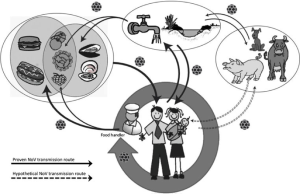Personal hygiene of farm workers is considered an important factor that influences transfer of pathogenic bacteria to fresh produce. Coliforms have been isolated from fresh produce at different stages of production and processing, and while they are often considered an indicator of animal and human fecal contamination, their presence on produce can be ambiguous. In contrast, infected workers are considered the primary source of viruses that cause foodborne illness and Shigella.
Human noroviruses (NoVs) are considered a worldwide leading cause of acute non-bacterial gastroenteritis. Person-to-person transmission is without a doubt the dominant transmission route for NoV, but the primary cases in NoV outbreaks often have a food or water borne cause. Food products can be contaminated with NoV by contact with fecal material or vomit, which can occur during any stage of the food production.
In essence, NoV contamination of foods can occur during at a pre-harvest level, e.g., by irrigation of fresh produce with NoV contaminated water or by use of contaminated manure, or at a (post-) harvest level, e.g., by manual picking, processing, and preparation of foods such as strawberries and raspberries.
Fig. 1 Schematic overview of the transmission routes of human and animal infective NoVs. Solid and dashed arrows indicate proven and hypothetical transmission routes, respectively. The thickness of the arrows is related to the likeliness of the transmission route
